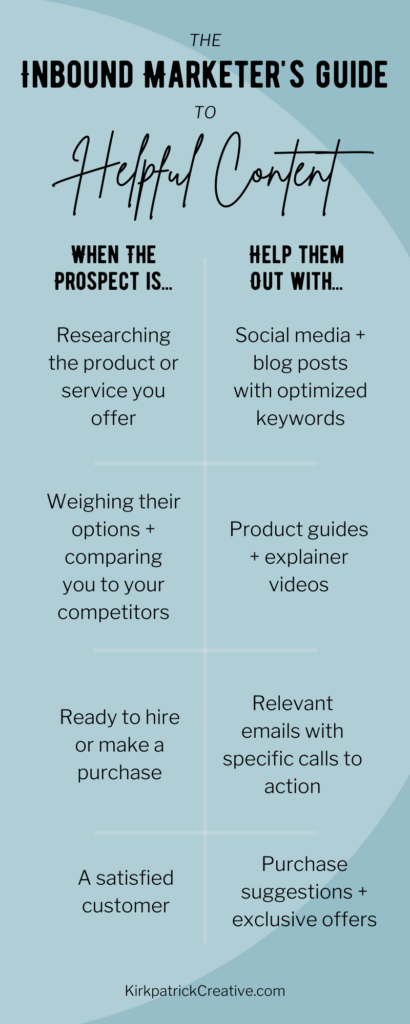What is Inbound Marketing?
Inbound marketing recognizes that customers research brands and their products and services on their own time.
While outbound marketing goes from the advertiser to the customer—TV, billboards, direct mail, etc.—inbound marketing is the opposite: you create content that is available for prospects to find.
Inbound marketing is…
- Less intrusive
- More helpful to the consumer
- Great for SEO
- Effective at establishing authority
Learn More: 6 Types of Brand Awareness Campaigns (and How to Generate Leads from Them)
Why Choose Inbound Marketing?
Reason #1: Help Customers Help Themselves
Informing customers is the way to gain their trust and business. If you don’t give your ideal customer the information they need (and want!) to make an informed decision, your competitors will.
To do this most effectively, walk with them through their buyer’s journey. Be there when they have a question and you’re more likely to be the one they turn to when they’re ready to buy.
Learn More: Why Customer Context Matters (and How to Make it Work for You)
Reason #2: Get Qualified Leads
Inbound leads are more qualified than outbound leads. By nurturing them through the buyer’s journey, you know exactly how qualified each lead is—there’ll be no wasting your time on cold ones.
Learn More: 4 of the Best Direct-to-Consumer Marketing Strategies to Use (Even if You’re Not D2C)
Reason #3: Save Money
Inbound marketing is primarily focused on growing organic leads—in other words, prospects that you don’t pay for. While creating inbound marketing content isn’t 100% free, it’s far more cost-effective over time than pay-per-click advertising, paid search, and traditional outbound media like commercials and billboards.
Learn More: 3 Ways Data-Driven Marketing Saves You Money
How Do I Do Inbound Marketing Well?
Rule #1: Have a Great Website
Your website needs to represent you and work well. Plus, it’s likely where all your content will be hosted (or at least linked to). It’s essential that you have a fantastic website or you’ll turn people away.
Learn More: 6 Clever Tips for Building Trust in Your Brand (and They Can All be Done Online)
Rule # 2: Create Great Content
The key to inbound marketing is content—and the key to great content is to guide the potential buyer through their journey.
Before we get into that with further detail, here’s an at-a-glance guide to what kind of content is most useful to the customer at different phases in their buying cycle:
Stage 1: Doing Research
Long-tail keywords in blog posts and your social media content will help prospects find you during their research into new products and/or services.
Learn More: Is Your Social Media SEO-Friendly?
Stage 2: Considering Choices
Product guides like brochures and videos are the best way to assist the customer who is weighing their options. Make it clear why they should choose instead of your competitors.
Learn More: Effective Doesn’t Have to Mean Expensive in Video Marketing
Stage 3: Ready to Buy
When the buyer is ready to make a purchase or hire, help them do it without friction. Send them emails featuring specific calls to action to buy the product they’ve been looking at NOW! Create a sense of urgency: Entice them with a discount code or emphasize that a sale is about to end soon.
Learn More: Troubleshooting Your Email Marketing
Stage 4: Coming Back for More
Keep satisfied customers happy by emailing them purchase suggestions and exclusive offers. If applicable, send service reminders and tips. Invite them to follow your social media pages to reinforce a sense of community and trust.
Talk to an Inbound Marketing Agency in Little Rock Today
Ready to start an inbound marketing campaign that nurtures your prospects through every step of their purchasing journey? Contact Kirkpatrick Creative today for inbound marketing that’s engineered to work.

![A Guide to Inbound Marketing [FREE Infographic]](https://kirkpatrickcreative.com/wp-content/uploads/2022/05/melanie-deziel-U33fHryBYBU-unsplash-1200x600.jpg)
